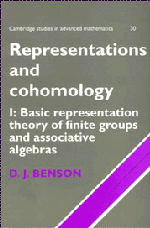Book contents
Chapter 5 - Representation rings and Burnside rings
Published online by Cambridge University Press: 26 January 2010
Summary
Representation rings are a convenient way of organising information about direct sums and tensor products of modules. J. A. Green was the first person to make a systematic investigation of representation rings in the 1960's. For this reason representation rings are also known as Green rings. In this chapter we investigate representation theory from the point of view of the structure of representation rings.
In the study of representation theory in characteristic zero, it is customary to work in terms of the character table, namely the square table whose rows are indexed by the ordinary irreducible representations, whose columns are indexed by the conjugacy classes of group elements, and where a typical entry gives the trace of the group element on the representation. Why do we use the trace function? This is because the maps M ↦ tr(g, M) are precisely the ring homomorphisms from the representation ring to ℂ, and these homomorphisms separate representations. In particular, in this case the representation ring is semisimple. This has the effect that we can compute with representations easily and effectively in terms of their characters; representations are distinguished by their characters, direct sum corresponds to addition and tensor product corresponds to multiplication. The orthogonality relations state that we may determine the dimension of the space of homomorphisms from one representation to another by taking the inner product of their characters.
- Type
- Chapter
- Information
- Representations and Cohomology , pp. 171 - 200Publisher: Cambridge University PressPrint publication year: 1991

